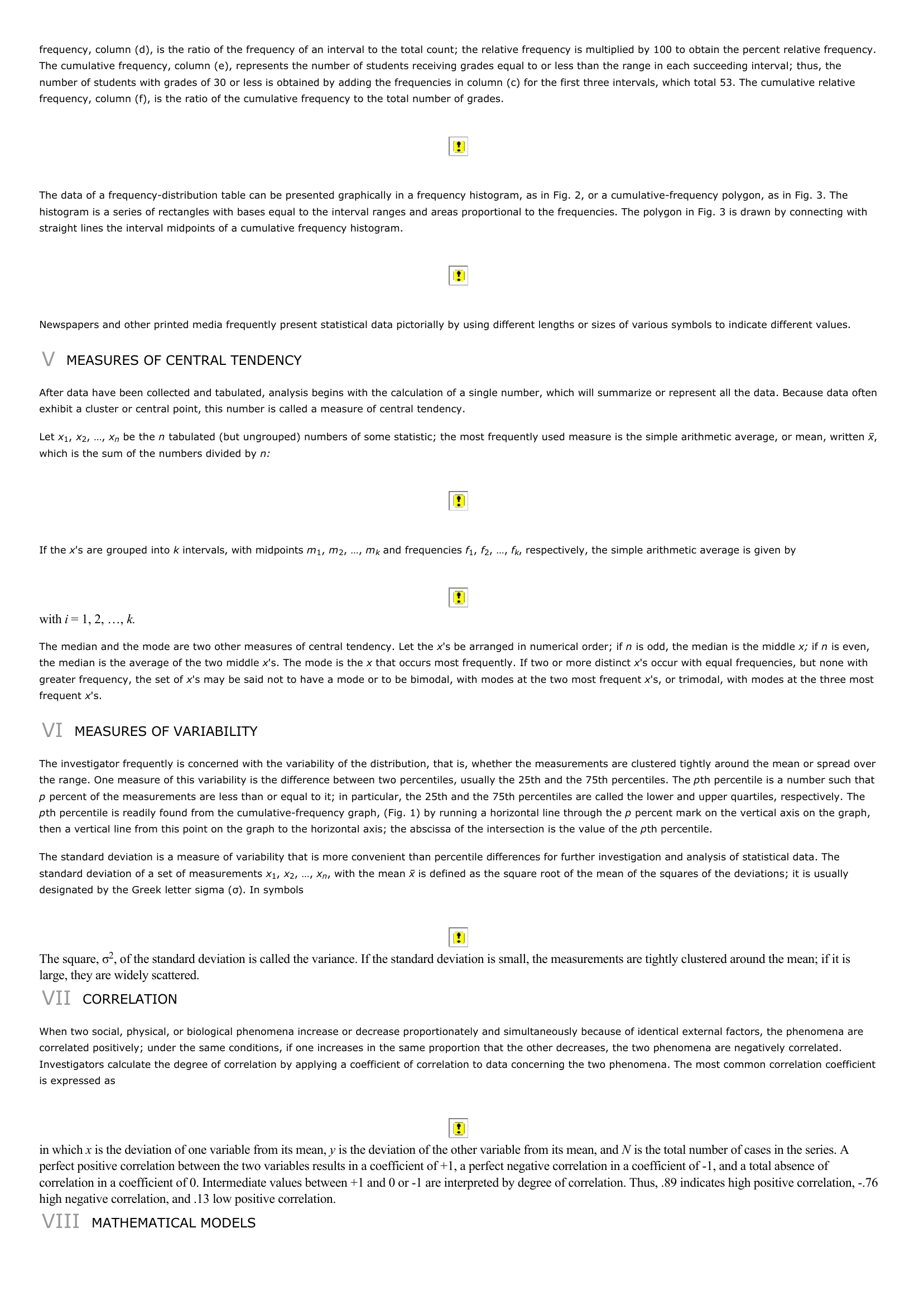Statistics I INTRODUCTION Statistics, branch of mathematics that deals with the collection, organization, and analysis of numerical data and with such problems as experiment design and decision making.
Publié le 12/05/2013

Extrait du document
«
frequency, column (d), is the ratio of the frequency of an interval to the total count; the relative frequency is multiplied by 100 to obtain the percent relative frequency.The cumulative frequency, column (e), represents the number of students receiving grades equal to or less than the range in each succeeding interval; thus, thenumber of students with grades of 30 or less is obtained by adding the frequencies in column (c) for the first three intervals, which total 53.
The cumulative relativefrequency, column (f), is the ratio of the cumulative frequency to the total number of grades.
The data of a frequency-distribution table can be presented graphically in a frequency histogram, as in Fig.
2, or a cumulative-frequency polygon, as in Fig.
3.
Thehistogram is a series of rectangles with bases equal to the interval ranges and areas proportional to the frequencies.
The polygon in Fig.
3 is drawn by connecting withstraight lines the interval midpoints of a cumulative frequency histogram.
Newspapers and other printed media frequently present statistical data pictorially by using different lengths or sizes of various symbols to indicate different values.
V MEASURES OF CENTRAL TENDENCY
After data have been collected and tabulated, analysis begins with the calculation of a single number, which will summarize or represent all the data.
Because data oftenexhibit a cluster or central point, this number is called a measure of central tendency.
Let x1, x2, …, xn be the n tabulated (but ungrouped) numbers of some statistic; the most frequently used measure is the simple arithmetic average, or mean, written , which is the sum of the numbers divided by n:
If the x's are grouped into k intervals, with midpoints m1, m2, …, mk and frequencies f1, f2, …, fk, respectively, the simple arithmetic average is given by
with i = 1, 2, …, k.
The median and the mode are two other measures of central tendency.
Let the x's be arranged in numerical order; if n is odd, the median is the middle x; if n is even, the median is the average of the two middle x's.
The mode is the x that occurs most frequently.
If two or more distinct x's occur with equal frequencies, but none with greater frequency, the set of x's may be said not to have a mode or to be bimodal, with modes at the two most frequent x's, or trimodal, with modes at the three most frequent x's.
VI MEASURES OF VARIABILITY
The investigator frequently is concerned with the variability of the distribution, that is, whether the measurements are clustered tightly around the mean or spread overthe range.
One measure of this variability is the difference between two percentiles, usually the 25th and the 75th percentiles.
The pth percentile is a number such that p percent of the measurements are less than or equal to it; in particular, the 25th and the 75th percentiles are called the lower and upper quartiles, respectively.
Thepth percentile is readily found from the cumulative-frequency graph, (Fig.
1) by running a horizontal line through the p percent mark on the vertical axis on the graph, then a vertical line from this point on the graph to the horizontal axis; the abscissa of the intersection is the value of the pth percentile.
The standard deviation is a measure of variability that is more convenient than percentile differences for further investigation and analysis of statistical data.
Thestandard deviation of a set of measurements x1, x2, …, xn, with the mean is defined as the square root of the mean of the squares of the deviations; it is usually designated by the Greek letter sigma (σ).
In symbols
The square, σ 2, of the standard deviation is called the variance.
If the standard deviation is small, the measurements are tightly clustered around the mean; if it is large, they are widely scattered.
VII CORRELATION
When two social, physical, or biological phenomena increase or decrease proportionately and simultaneously because of identical external factors, the phenomena arecorrelated positively; under the same conditions, if one increases in the same proportion that the other decreases, the two phenomena are negatively correlated.Investigators calculate the degree of correlation by applying a coefficient of correlation to data concerning the two phenomena.
The most common correlation coefficientis expressed as
in which x is the deviation of one variable from its mean, y is the deviation of the other variable from its mean, and N is the total number of cases in the series.
A perfect positive correlation between the two variables results in a coefficient of +1, a perfect negative correlation in a coefficient of -1, and a total absence ofcorrelation in a coefficient of 0.
Intermediate values between +1 and 0 or -1 are interpreted by degree of correlation.
Thus, .89 indicates high positive correlation, -.76high negative correlation, and .13 low positive correlation.
VIII MATHEMATICAL MODELS.
»
↓↓↓ APERÇU DU DOCUMENT ↓↓↓
Liens utiles
- Statistics I INTRODUCTION Statistics, branch of mathematics that deals with the collection, organization, and analysis of numerical data and with such problems as experiment design and decision making.
- Trigonometry I INTRODUCTION Trigonometry, branch of mathematics that deals with the relationships between the sides and angles of triangles and with the properties and applications of the trigonometric functions of angles.
- Number Theory I INTRODUCTION Number Theory, branch of mathematics that deals with the properties and relationships of numbers (see Number).
- Geometry I INTRODUCTION Geometry, branch of mathematics that deals with shapes and sizes.
- Nathaniel Hawthorne I INTRODUCTION Nathaniel Hawthorne (1804-1864), American novelist, whose works are deeply concerned with the ethical problems of sin, punishment, and atonement.

































